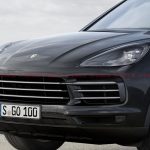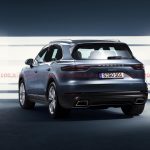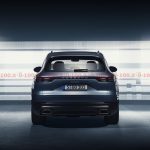Anteprima Francoforte 2017: la nuova Porsche Cayenne Model Year 2018[:en]IAA 2017: the new Porsche Cayenne 2018 is even closer to the 911
TRIPLICE ALLEANZA. LA CAYENNE ENTRA NELLA TERZA GENERAZIONE. IL PACHIDERMICO SUV TEDESCO, AMALGAMA DI FUORISTRADA / AUTO SPORTIVA / BERLINA DI LUSSO, E’ LEGGERMENTE PIU’ LEGGERO (-84 KG IN MEDIA) E ANCORA PIU’ RICCO DI TECNOLOGIA. DEBUTTANO L’ASSE POSTERIORE STERZANTE, NUOVA TIPOLOGIA DI FRENI, BATTERIA AL LITIO DI SERIE. SI INIZIA, IN LISTINO, CON CAYENNE E CAYENNE S.
Porsche presenta al salone di Francoforte 2017 la terza generazione della Cayenne. L’ultima evoluzione del grande SUV di Stoccarda, in listino ormai dal 2004, presenta al pubblico numerose novità tecniche che, secondo il costruttore, producono un vero salto di qualità rispetto al modello precedente.
DESIGN
La Cayenne mantiene lo stesso passo (2.895 mm) ma è cresciuta in lunghezza di oltre 6 centimetri e si è abbassata di quasi 1 centimetro. Misura 4.918 mm, con 1.983 di larghezza, offrendo un bagagliaio che, in configurazione standard, produce 770 litri, ben 100 litri in più.
La forma della Cayenne continua a proporre il grande muso affilato, dove ora grande calandra e prese d’aria laterali (maggiorate), producono un’unica superficie di ingresso per il flusso diretto ai radiatori. Posteriormente spiccano le luci sottili inserite in un unica fascia luminosa che percorre tutto il portellone.
MOTORE E TRASMISSIONE
Al debutto il listino si compone di Cayenne e Cayenne S. La prima versione è equipaggiata con un V6 turbo 3 litri di origine Volkswagen da 340 Cv e 450 Nm di coppia massima. La Cayenne S, invece, utilizza un V6 biturbo da 2,9 litri per 440 Cv e e 550 Nm.
Entrambe utilizzano una nuova tipologia del cambio automatico Tiptronic S a 8 marce con funzionamento più veloce e rapporti modificati (più corti quelli delle marce alte, più lunga l’ottava) e trazione integrale PTM.
TELAIO
Grazie all’ancora più esteso utilizzo di alluminio per scocca e carrozzeria, il peso della Cayenne è diminuito mediamente di oltre 80 kg (si segnala anche l’utilizzo di una batteria al litio che toglie ulteriori 10 kg). Ora la Casa Madre dichiara che il peso a vuoto è sceso da 2.040 a 1.985 kg nonostante un allestimento molto più ricco.
Lo schema sospensivo conserva l’architettura anteriore con schema a bracci indipendenti e posteriori multilink, coadiuvati da un largo utilizzo di elettronica. Sono infatti disponibili ammortizzatori a controllo elettronico PASM (di serie su Cayenne S), stabilizzatore di rollio opzionale Porsche Dynamic Chassis Control (PDCC), sistema di regolazione del telaio Porsche 4D-Chassis-Control e, per la prima volta, asse posteriore sterzante come sulla 911.
Viene inoltre, introdotta, una nuova tipologia di freni, il Porsche Surface Coated Brake (PSCB), che consiste in un treno di dischi in ghisa ma rivestiti con carburo di tungsteno che migliora l’attrito, riduce la formazione di polveri e l’usura. Si contraddistingue per le pinze-freno in colore bianco. Sarà in seguito disponibile, naturalmente, il PCCB con dischi in carboceramica e pinze gialle.
La nuova Cayenne, infine, monta ruote da 19″ che possono aumentare fino a 21″ attingendo al catalogo accessori.
PRESTAZIONI E CONSUMI
Secondo Porsche la Cayenne scatta sullo 0-100 in 6″2 (5″9 se equipaggiata con il pacchetto Sport Chrono) e raggiunge 245 km/h. Il consumo medio dichiarato è variabile tra 9 e 9,2 l/100 km ( emissioni di CO2 209 – 205 g/km).
La Cayenne S percorre lo 0-100 in 5″2 (4″9 con Sport Chrono) e 265 km/h di velocità massima, con un consumo medio di 9,2/9,4 l/100 km (emissioni di CO2 213 – 209 g/km).
THE NEW PORSCHE CAYENNE IS BASED HEAVILY ON THE ICONIC 911 SPORTS CAR: THE THIRD EDITION OF THE SUV, WHICH HAS ALSO BEEN ENHANCED VISUALLY, NOW HAS POWERFUL TURBO ENGINES, NEW EIGHT-SPEED TIPTRONIC S GEARBOX, NEW CHASSIS SYSTEMS AND NEW CONNECTIVITY DEVICES.
The appearance of the Cayenne has been enhanced in the style through enlarged air intakes at the front, new horizontal light edges and the redesigned rear lights with three-dimensional light design and end-to-end narrow strip of LEDs.
With an exterior length increased by 63 millimetres without any change to the wheelbase (2,895 millimetres) and a roof height reduced by nine millimetres compared with its predecessor, the elegant, streamlined impression of the Cayenne, which is 4,918 millimetres long and 1,983 millimetres wide (excluding mirrors), has been noticeably enhanced. The luggage compartment volume is now 770 litres – an increase of 100 litres.
ENGINES AND TRANSMISSION
Two variants are available: The Cayenne with a six-cylinder turbo engine and displacement of three litres delivers 250 kW (340 hp), developing a torque of 450 Nm. It accelerates from zero to 100 km/h in 6.2 seconds (5.9 seconds with the Sport Chrono Package). The maximum speed is 245 km/h. The second model to launch is the Cayenne S. It is driven by a 2.9-litre V6 engine with twin turbocharging. This engine, which has also been newly developed, delivers 324 kW (440 hp), achieving a torque of 550 Nm – 15 kW (20 hp) more than its predecessor. Accordingly, the vehicle accelerates from zero to 100 km/h in just 5.2 seconds (with Sport Chrono Package: 4.9 seconds). The maximum speed is 265 km/h.
Both are equipped with newly developed Tiptronic S gearbox and PTM all wheel drive system.
CHASSIS
The new Porsche cayenne boasts a new lightweight chassis base with a front axle featuring a separated link design and a multi-link rear axle. The exterior is made entirely of aluminium. The floorpan assembly, front section and virtually all the chassis components are also manufactured from alloy. In total, the weight of the Cayenne when empty has been reduced from 2,040 to 1,985 kilograms
A typical sports car feature is the new mixed tyres, which are now on wheels of at least 19 inches. The mixed tyres improve stability and driving dynamics on bends. Porsche offers wheel sizes up to 21 inches as an option.
All chassis systems are integrated by the Porsche 4D Chassis Control system, which works in real time, optimising handling even further. For the first time the Cayenne is available with electric rear-axle steering. The system, tried and tested both in the 911 and the Panamera.
The optional adaptive air suspension (with PASM) with new three-chamber technology significantly increases the spread between a sporty, firm connection and the driving comfort expected of a touring car. . With the optional Porsche Dynamic Chassis Control (PDCC) roll stabilisation, sporty drivers benefit by changing from a hydraulic to an electric system.
Assuming once again a pioneering role in the development of high-performance brakes, Porsche launches on the Cayenne the Porsche Surface Coated Brake (PSCB): it consists of a cast-iron disc with a tungsten-carbide coating. This finish increases the friction values and wear and brake dust are reduced. The brake callipers are painted white.
Porsche has redeveloped the Sport Chrono Package based on the model of the sports car. The Mode button on the steering wheel is one clear indicator of this approach. As well as the Normal, Sport and Sport Plus driving modes, the driver can select an individually configurable mode.
The Cayenne is available in Germany from EUR 74,828. Prices for the Cayenne S begin at EUR 91,964 – each including VAT and country-specific features.































